Mental Health Nursing: Assessment, Intervention, and Recovery
VerifiedAdded on 2023/06/07
|12
|3017
|270
AI Summary
This article discusses the assessment, intervention, and recovery of a patient with schizophrenia. It covers the patient's appearance, speech, mood, form of thought, content of thought, perception, sensorium and cognition, insight and judgment, and risk assessment. It also explores presenting, precipitating, predisposing, perpetuating, and protective factors. Additionally, it discusses therapeutic relationship, cultural safety, and nursing interventions based on principles of recovery-oriented mental health practice.
Contribute Materials
Your contribution can guide someone’s learning journey. Share your
documents today.

Running head: MENTAL HEALTH NURSING
Mental health nursing
Name of the student
Name of the university
Author note
Mental health nursing
Name of the student
Name of the university
Author note
Secure Best Marks with AI Grader
Need help grading? Try our AI Grader for instant feedback on your assignments.
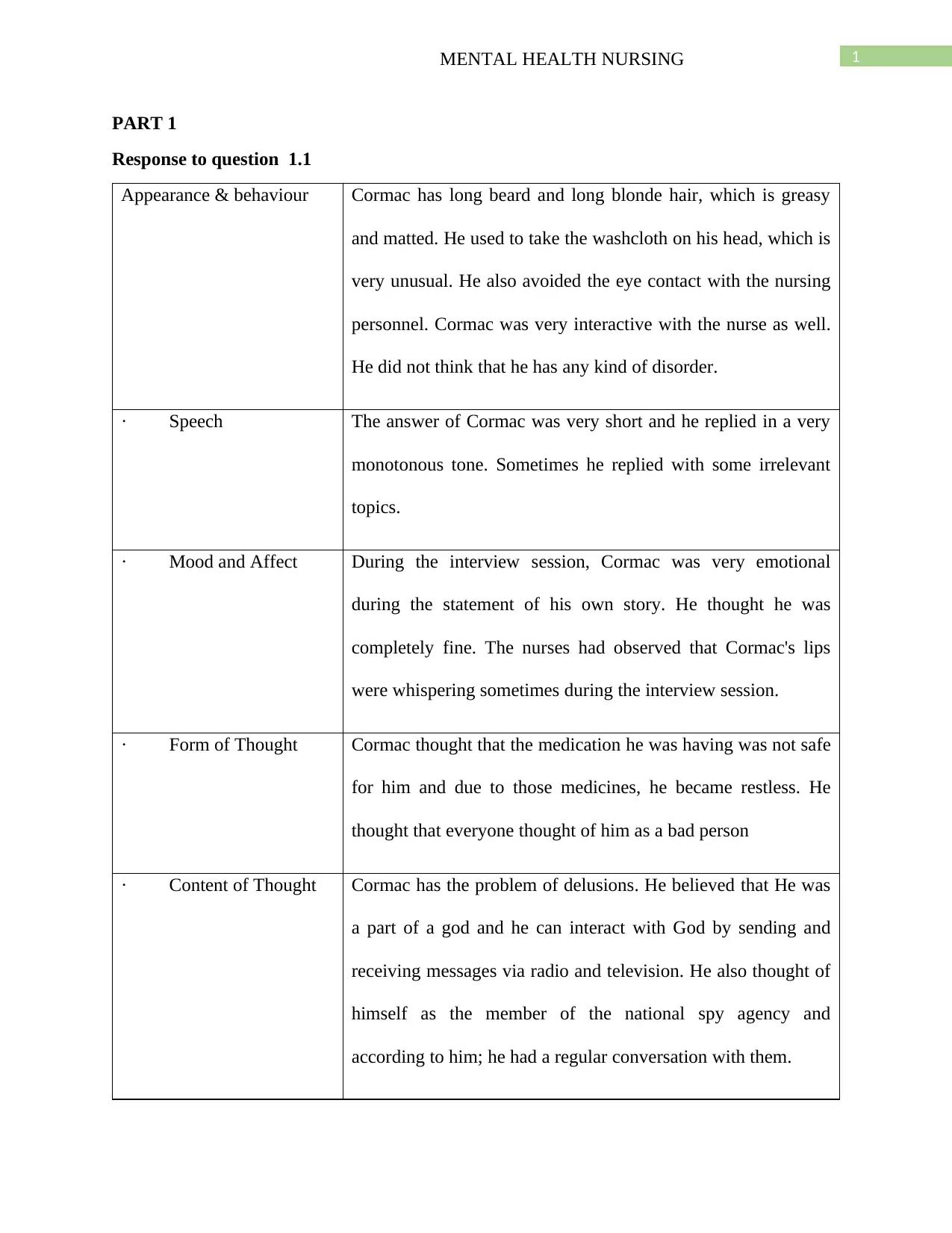
1MENTAL HEALTH NURSING
PART 1
Response to question 1.1
Appearance & behaviour Cormac has long beard and long blonde hair, which is greasy
and matted. He used to take the washcloth on his head, which is
very unusual. He also avoided the eye contact with the nursing
personnel. Cormac was very interactive with the nurse as well.
He did not think that he has any kind of disorder.
· Speech The answer of Cormac was very short and he replied in a very
monotonous tone. Sometimes he replied with some irrelevant
topics.
· Mood and Affect During the interview session, Cormac was very emotional
during the statement of his own story. He thought he was
completely fine. The nurses had observed that Cormac's lips
were whispering sometimes during the interview session.
· Form of Thought Cormac thought that the medication he was having was not safe
for him and due to those medicines, he became restless. He
thought that everyone thought of him as a bad person
· Content of Thought Cormac has the problem of delusions. He believed that He was
a part of a god and he can interact with God by sending and
receiving messages via radio and television. He also thought of
himself as the member of the national spy agency and
according to him; he had a regular conversation with them.
PART 1
Response to question 1.1
Appearance & behaviour Cormac has long beard and long blonde hair, which is greasy
and matted. He used to take the washcloth on his head, which is
very unusual. He also avoided the eye contact with the nursing
personnel. Cormac was very interactive with the nurse as well.
He did not think that he has any kind of disorder.
· Speech The answer of Cormac was very short and he replied in a very
monotonous tone. Sometimes he replied with some irrelevant
topics.
· Mood and Affect During the interview session, Cormac was very emotional
during the statement of his own story. He thought he was
completely fine. The nurses had observed that Cormac's lips
were whispering sometimes during the interview session.
· Form of Thought Cormac thought that the medication he was having was not safe
for him and due to those medicines, he became restless. He
thought that everyone thought of him as a bad person
· Content of Thought Cormac has the problem of delusions. He believed that He was
a part of a god and he can interact with God by sending and
receiving messages via radio and television. He also thought of
himself as the member of the national spy agency and
according to him; he had a regular conversation with them.
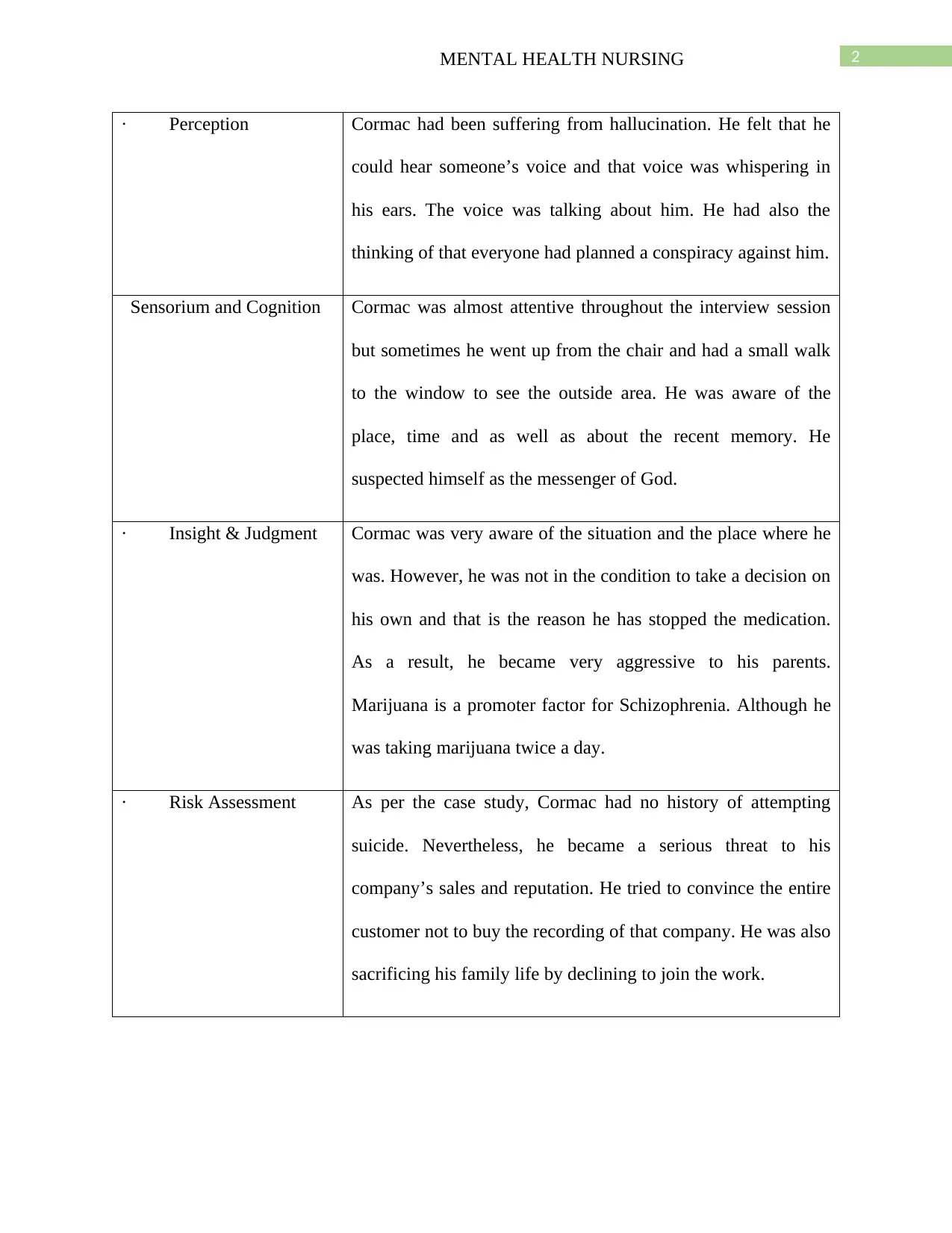
2MENTAL HEALTH NURSING
· Perception Cormac had been suffering from hallucination. He felt that he
could hear someone’s voice and that voice was whispering in
his ears. The voice was talking about him. He had also the
thinking of that everyone had planned a conspiracy against him.
Sensorium and Cognition Cormac was almost attentive throughout the interview session
but sometimes he went up from the chair and had a small walk
to the window to see the outside area. He was aware of the
place, time and as well as about the recent memory. He
suspected himself as the messenger of God.
· Insight & Judgment Cormac was very aware of the situation and the place where he
was. However, he was not in the condition to take a decision on
his own and that is the reason he has stopped the medication.
As a result, he became very aggressive to his parents.
Marijuana is a promoter factor for Schizophrenia. Although he
was taking marijuana twice a day.
· Risk Assessment As per the case study, Cormac had no history of attempting
suicide. Nevertheless, he became a serious threat to his
company’s sales and reputation. He tried to convince the entire
customer not to buy the recording of that company. He was also
sacrificing his family life by declining to join the work.
· Perception Cormac had been suffering from hallucination. He felt that he
could hear someone’s voice and that voice was whispering in
his ears. The voice was talking about him. He had also the
thinking of that everyone had planned a conspiracy against him.
Sensorium and Cognition Cormac was almost attentive throughout the interview session
but sometimes he went up from the chair and had a small walk
to the window to see the outside area. He was aware of the
place, time and as well as about the recent memory. He
suspected himself as the messenger of God.
· Insight & Judgment Cormac was very aware of the situation and the place where he
was. However, he was not in the condition to take a decision on
his own and that is the reason he has stopped the medication.
As a result, he became very aggressive to his parents.
Marijuana is a promoter factor for Schizophrenia. Although he
was taking marijuana twice a day.
· Risk Assessment As per the case study, Cormac had no history of attempting
suicide. Nevertheless, he became a serious threat to his
company’s sales and reputation. He tried to convince the entire
customer not to buy the recording of that company. He was also
sacrificing his family life by declining to join the work.
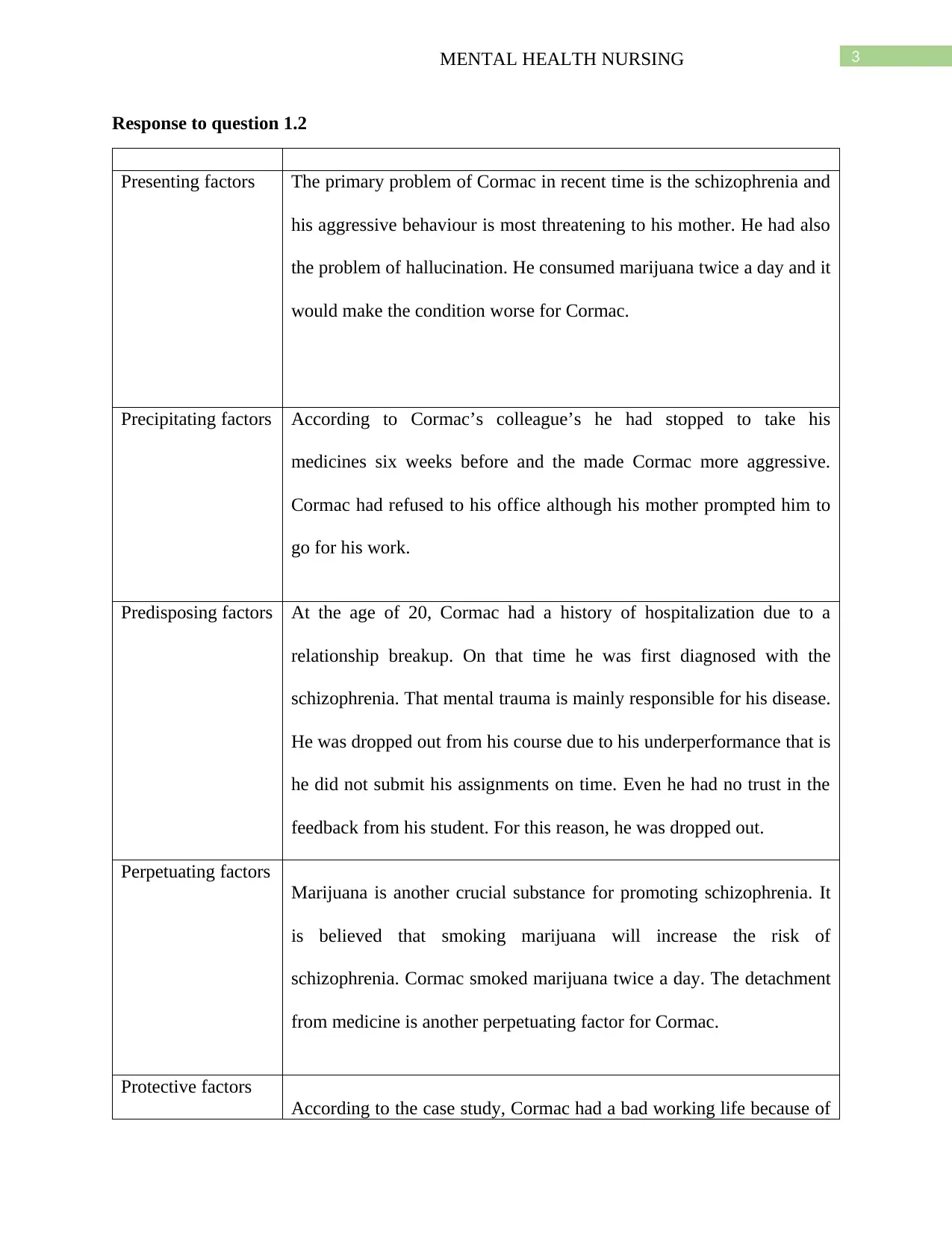
3MENTAL HEALTH NURSING
Response to question 1.2
Presenting factors The primary problem of Cormac in recent time is the schizophrenia and
his aggressive behaviour is most threatening to his mother. He had also
the problem of hallucination. He consumed marijuana twice a day and it
would make the condition worse for Cormac.
Precipitating factors According to Cormac’s colleague’s he had stopped to take his
medicines six weeks before and the made Cormac more aggressive.
Cormac had refused to his office although his mother prompted him to
go for his work.
Predisposing factors At the age of 20, Cormac had a history of hospitalization due to a
relationship breakup. On that time he was first diagnosed with the
schizophrenia. That mental trauma is mainly responsible for his disease.
He was dropped out from his course due to his underperformance that is
he did not submit his assignments on time. Even he had no trust in the
feedback from his student. For this reason, he was dropped out.
Perpetuating factors
Marijuana is another crucial substance for promoting schizophrenia. It
is believed that smoking marijuana will increase the risk of
schizophrenia. Cormac smoked marijuana twice a day. The detachment
from medicine is another perpetuating factor for Cormac.
Protective factors
According to the case study, Cormac had a bad working life because of
Response to question 1.2
Presenting factors The primary problem of Cormac in recent time is the schizophrenia and
his aggressive behaviour is most threatening to his mother. He had also
the problem of hallucination. He consumed marijuana twice a day and it
would make the condition worse for Cormac.
Precipitating factors According to Cormac’s colleague’s he had stopped to take his
medicines six weeks before and the made Cormac more aggressive.
Cormac had refused to his office although his mother prompted him to
go for his work.
Predisposing factors At the age of 20, Cormac had a history of hospitalization due to a
relationship breakup. On that time he was first diagnosed with the
schizophrenia. That mental trauma is mainly responsible for his disease.
He was dropped out from his course due to his underperformance that is
he did not submit his assignments on time. Even he had no trust in the
feedback from his student. For this reason, he was dropped out.
Perpetuating factors
Marijuana is another crucial substance for promoting schizophrenia. It
is believed that smoking marijuana will increase the risk of
schizophrenia. Cormac smoked marijuana twice a day. The detachment
from medicine is another perpetuating factor for Cormac.
Protective factors
According to the case study, Cormac had a bad working life because of
Secure Best Marks with AI Grader
Need help grading? Try our AI Grader for instant feedback on your assignments.
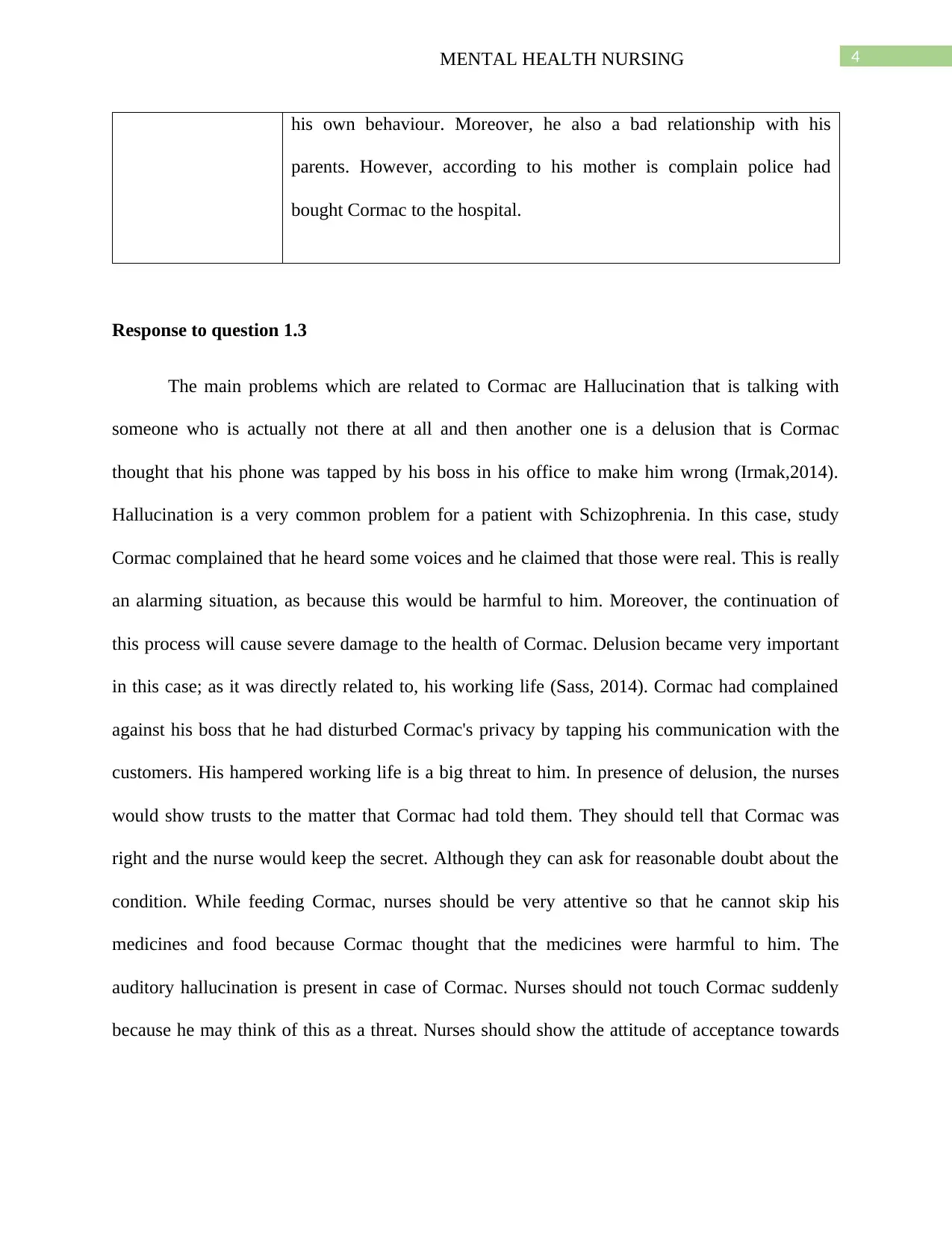
4MENTAL HEALTH NURSING
his own behaviour. Moreover, he also a bad relationship with his
parents. However, according to his mother is complain police had
bought Cormac to the hospital.
Response to question 1.3
The main problems which are related to Cormac are Hallucination that is talking with
someone who is actually not there at all and then another one is a delusion that is Cormac
thought that his phone was tapped by his boss in his office to make him wrong (Irmak,2014).
Hallucination is a very common problem for a patient with Schizophrenia. In this case, study
Cormac complained that he heard some voices and he claimed that those were real. This is really
an alarming situation, as because this would be harmful to him. Moreover, the continuation of
this process will cause severe damage to the health of Cormac. Delusion became very important
in this case; as it was directly related to, his working life (Sass, 2014). Cormac had complained
against his boss that he had disturbed Cormac's privacy by tapping his communication with the
customers. His hampered working life is a big threat to him. In presence of delusion, the nurses
would show trusts to the matter that Cormac had told them. They should tell that Cormac was
right and the nurse would keep the secret. Although they can ask for reasonable doubt about the
condition. While feeding Cormac, nurses should be very attentive so that he cannot skip his
medicines and food because Cormac thought that the medicines were harmful to him. The
auditory hallucination is present in case of Cormac. Nurses should not touch Cormac suddenly
because he may think of this as a threat. Nurses should show the attitude of acceptance towards
his own behaviour. Moreover, he also a bad relationship with his
parents. However, according to his mother is complain police had
bought Cormac to the hospital.
Response to question 1.3
The main problems which are related to Cormac are Hallucination that is talking with
someone who is actually not there at all and then another one is a delusion that is Cormac
thought that his phone was tapped by his boss in his office to make him wrong (Irmak,2014).
Hallucination is a very common problem for a patient with Schizophrenia. In this case, study
Cormac complained that he heard some voices and he claimed that those were real. This is really
an alarming situation, as because this would be harmful to him. Moreover, the continuation of
this process will cause severe damage to the health of Cormac. Delusion became very important
in this case; as it was directly related to, his working life (Sass, 2014). Cormac had complained
against his boss that he had disturbed Cormac's privacy by tapping his communication with the
customers. His hampered working life is a big threat to him. In presence of delusion, the nurses
would show trusts to the matter that Cormac had told them. They should tell that Cormac was
right and the nurse would keep the secret. Although they can ask for reasonable doubt about the
condition. While feeding Cormac, nurses should be very attentive so that he cannot skip his
medicines and food because Cormac thought that the medicines were harmful to him. The
auditory hallucination is present in case of Cormac. Nurses should not touch Cormac suddenly
because he may think of this as a threat. Nurses should show the attitude of acceptance towards
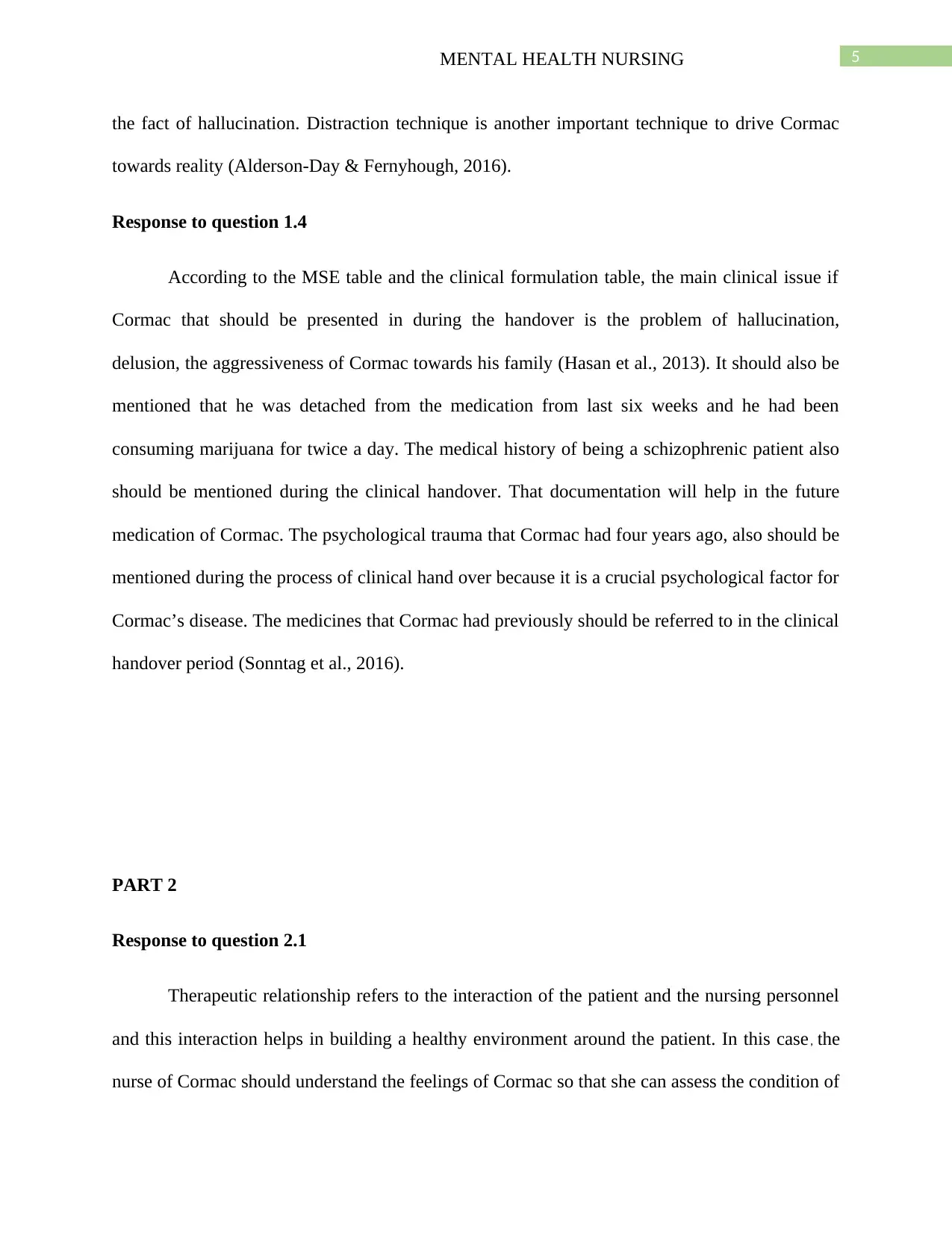
5MENTAL HEALTH NURSING
the fact of hallucination. Distraction technique is another important technique to drive Cormac
towards reality (Alderson-Day & Fernyhough, 2016).
Response to question 1.4
According to the MSE table and the clinical formulation table, the main clinical issue if
Cormac that should be presented in during the handover is the problem of hallucination,
delusion, the aggressiveness of Cormac towards his family (Hasan et al., 2013). It should also be
mentioned that he was detached from the medication from last six weeks and he had been
consuming marijuana for twice a day. The medical history of being a schizophrenic patient also
should be mentioned during the clinical handover. That documentation will help in the future
medication of Cormac. The psychological trauma that Cormac had four years ago, also should be
mentioned during the process of clinical hand over because it is a crucial psychological factor for
Cormac’s disease. The medicines that Cormac had previously should be referred to in the clinical
handover period (Sonntag et al., 2016).
PART 2
Response to question 2.1
Therapeutic relationship refers to the interaction of the patient and the nursing personnel
and this interaction helps in building a healthy environment around the patient. In this case, the
nurse of Cormac should understand the feelings of Cormac so that she can assess the condition of
the fact of hallucination. Distraction technique is another important technique to drive Cormac
towards reality (Alderson-Day & Fernyhough, 2016).
Response to question 1.4
According to the MSE table and the clinical formulation table, the main clinical issue if
Cormac that should be presented in during the handover is the problem of hallucination,
delusion, the aggressiveness of Cormac towards his family (Hasan et al., 2013). It should also be
mentioned that he was detached from the medication from last six weeks and he had been
consuming marijuana for twice a day. The medical history of being a schizophrenic patient also
should be mentioned during the clinical handover. That documentation will help in the future
medication of Cormac. The psychological trauma that Cormac had four years ago, also should be
mentioned during the process of clinical hand over because it is a crucial psychological factor for
Cormac’s disease. The medicines that Cormac had previously should be referred to in the clinical
handover period (Sonntag et al., 2016).
PART 2
Response to question 2.1
Therapeutic relationship refers to the interaction of the patient and the nursing personnel
and this interaction helps in building a healthy environment around the patient. In this case, the
nurse of Cormac should understand the feelings of Cormac so that she can assess the condition of
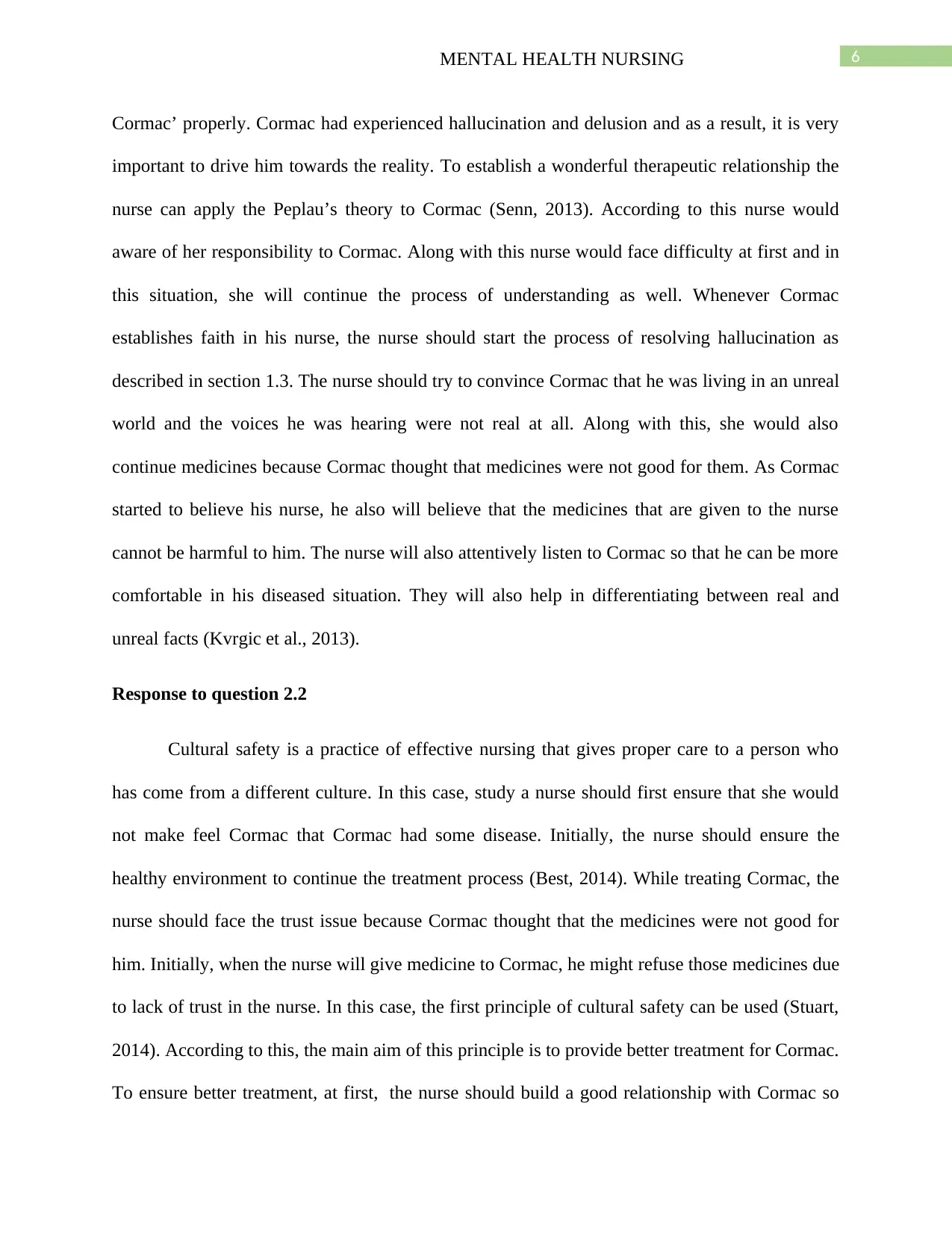
6MENTAL HEALTH NURSING
Cormac’ properly. Cormac had experienced hallucination and delusion and as a result, it is very
important to drive him towards the reality. To establish a wonderful therapeutic relationship the
nurse can apply the Peplau’s theory to Cormac (Senn, 2013). According to this nurse would
aware of her responsibility to Cormac. Along with this nurse would face difficulty at first and in
this situation, she will continue the process of understanding as well. Whenever Cormac
establishes faith in his nurse, the nurse should start the process of resolving hallucination as
described in section 1.3. The nurse should try to convince Cormac that he was living in an unreal
world and the voices he was hearing were not real at all. Along with this, she would also
continue medicines because Cormac thought that medicines were not good for them. As Cormac
started to believe his nurse, he also will believe that the medicines that are given to the nurse
cannot be harmful to him. The nurse will also attentively listen to Cormac so that he can be more
comfortable in his diseased situation. They will also help in differentiating between real and
unreal facts (Kvrgic et al., 2013).
Response to question 2.2
Cultural safety is a practice of effective nursing that gives proper care to a person who
has come from a different culture. In this case, study a nurse should first ensure that she would
not make feel Cormac that Cormac had some disease. Initially, the nurse should ensure the
healthy environment to continue the treatment process (Best, 2014). While treating Cormac, the
nurse should face the trust issue because Cormac thought that the medicines were not good for
him. Initially, when the nurse will give medicine to Cormac, he might refuse those medicines due
to lack of trust in the nurse. In this case, the first principle of cultural safety can be used (Stuart,
2014). According to this, the main aim of this principle is to provide better treatment for Cormac.
To ensure better treatment, at first, the nurse should build a good relationship with Cormac so
Cormac’ properly. Cormac had experienced hallucination and delusion and as a result, it is very
important to drive him towards the reality. To establish a wonderful therapeutic relationship the
nurse can apply the Peplau’s theory to Cormac (Senn, 2013). According to this nurse would
aware of her responsibility to Cormac. Along with this nurse would face difficulty at first and in
this situation, she will continue the process of understanding as well. Whenever Cormac
establishes faith in his nurse, the nurse should start the process of resolving hallucination as
described in section 1.3. The nurse should try to convince Cormac that he was living in an unreal
world and the voices he was hearing were not real at all. Along with this, she would also
continue medicines because Cormac thought that medicines were not good for them. As Cormac
started to believe his nurse, he also will believe that the medicines that are given to the nurse
cannot be harmful to him. The nurse will also attentively listen to Cormac so that he can be more
comfortable in his diseased situation. They will also help in differentiating between real and
unreal facts (Kvrgic et al., 2013).
Response to question 2.2
Cultural safety is a practice of effective nursing that gives proper care to a person who
has come from a different culture. In this case, study a nurse should first ensure that she would
not make feel Cormac that Cormac had some disease. Initially, the nurse should ensure the
healthy environment to continue the treatment process (Best, 2014). While treating Cormac, the
nurse should face the trust issue because Cormac thought that the medicines were not good for
him. Initially, when the nurse will give medicine to Cormac, he might refuse those medicines due
to lack of trust in the nurse. In this case, the first principle of cultural safety can be used (Stuart,
2014). According to this, the main aim of this principle is to provide better treatment for Cormac.
To ensure better treatment, at first, the nurse should build a good relationship with Cormac so
Paraphrase This Document
Need a fresh take? Get an instant paraphrase of this document with our AI Paraphraser
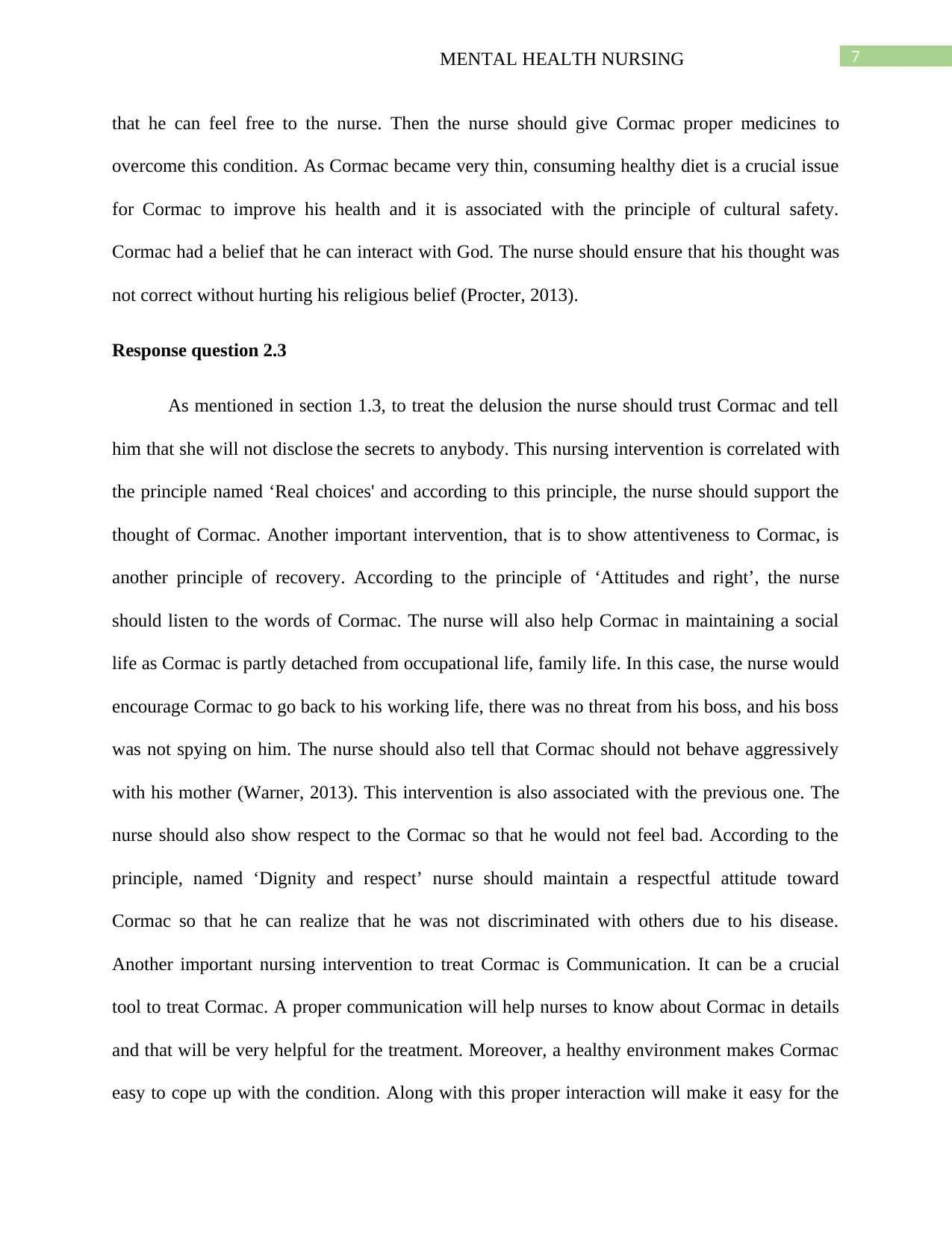
7MENTAL HEALTH NURSING
that he can feel free to the nurse. Then the nurse should give Cormac proper medicines to
overcome this condition. As Cormac became very thin, consuming healthy diet is a crucial issue
for Cormac to improve his health and it is associated with the principle of cultural safety.
Cormac had a belief that he can interact with God. The nurse should ensure that his thought was
not correct without hurting his religious belief (Procter, 2013).
Response question 2.3
As mentioned in section 1.3, to treat the delusion the nurse should trust Cormac and tell
him that she will not disclose the secrets to anybody. This nursing intervention is correlated with
the principle named ‘Real choices' and according to this principle, the nurse should support the
thought of Cormac. Another important intervention, that is to show attentiveness to Cormac, is
another principle of recovery. According to the principle of ‘Attitudes and right’, the nurse
should listen to the words of Cormac. The nurse will also help Cormac in maintaining a social
life as Cormac is partly detached from occupational life, family life. In this case, the nurse would
encourage Cormac to go back to his working life, there was no threat from his boss, and his boss
was not spying on him. The nurse should also tell that Cormac should not behave aggressively
with his mother (Warner, 2013). This intervention is also associated with the previous one. The
nurse should also show respect to the Cormac so that he would not feel bad. According to the
principle, named ‘Dignity and respect’ nurse should maintain a respectful attitude toward
Cormac so that he can realize that he was not discriminated with others due to his disease.
Another important nursing intervention to treat Cormac is Communication. It can be a crucial
tool to treat Cormac. A proper communication will help nurses to know about Cormac in details
and that will be very helpful for the treatment. Moreover, a healthy environment makes Cormac
easy to cope up with the condition. Along with this proper interaction will make it easy for the
that he can feel free to the nurse. Then the nurse should give Cormac proper medicines to
overcome this condition. As Cormac became very thin, consuming healthy diet is a crucial issue
for Cormac to improve his health and it is associated with the principle of cultural safety.
Cormac had a belief that he can interact with God. The nurse should ensure that his thought was
not correct without hurting his religious belief (Procter, 2013).
Response question 2.3
As mentioned in section 1.3, to treat the delusion the nurse should trust Cormac and tell
him that she will not disclose the secrets to anybody. This nursing intervention is correlated with
the principle named ‘Real choices' and according to this principle, the nurse should support the
thought of Cormac. Another important intervention, that is to show attentiveness to Cormac, is
another principle of recovery. According to the principle of ‘Attitudes and right’, the nurse
should listen to the words of Cormac. The nurse will also help Cormac in maintaining a social
life as Cormac is partly detached from occupational life, family life. In this case, the nurse would
encourage Cormac to go back to his working life, there was no threat from his boss, and his boss
was not spying on him. The nurse should also tell that Cormac should not behave aggressively
with his mother (Warner, 2013). This intervention is also associated with the previous one. The
nurse should also show respect to the Cormac so that he would not feel bad. According to the
principle, named ‘Dignity and respect’ nurse should maintain a respectful attitude toward
Cormac so that he can realize that he was not discriminated with others due to his disease.
Another important nursing intervention to treat Cormac is Communication. It can be a crucial
tool to treat Cormac. A proper communication will help nurses to know about Cormac in details
and that will be very helpful for the treatment. Moreover, a healthy environment makes Cormac
easy to cope up with the condition. Along with this proper interaction will make it easy for the
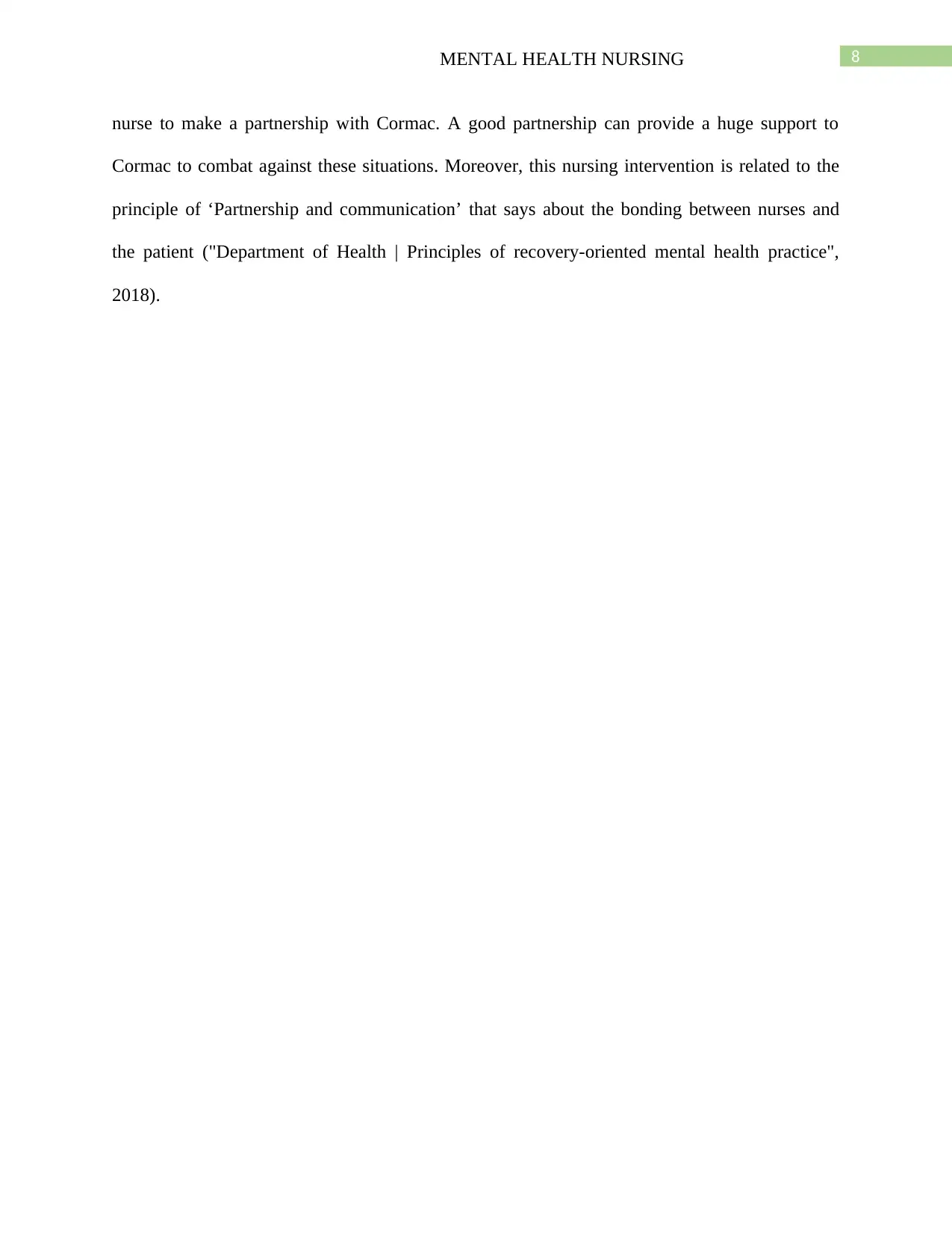
8MENTAL HEALTH NURSING
nurse to make a partnership with Cormac. A good partnership can provide a huge support to
Cormac to combat against these situations. Moreover, this nursing intervention is related to the
principle of ‘Partnership and communication’ that says about the bonding between nurses and
the patient ("Department of Health | Principles of recovery-oriented mental health practice",
2018).
nurse to make a partnership with Cormac. A good partnership can provide a huge support to
Cormac to combat against these situations. Moreover, this nursing intervention is related to the
principle of ‘Partnership and communication’ that says about the bonding between nurses and
the patient ("Department of Health | Principles of recovery-oriented mental health practice",
2018).
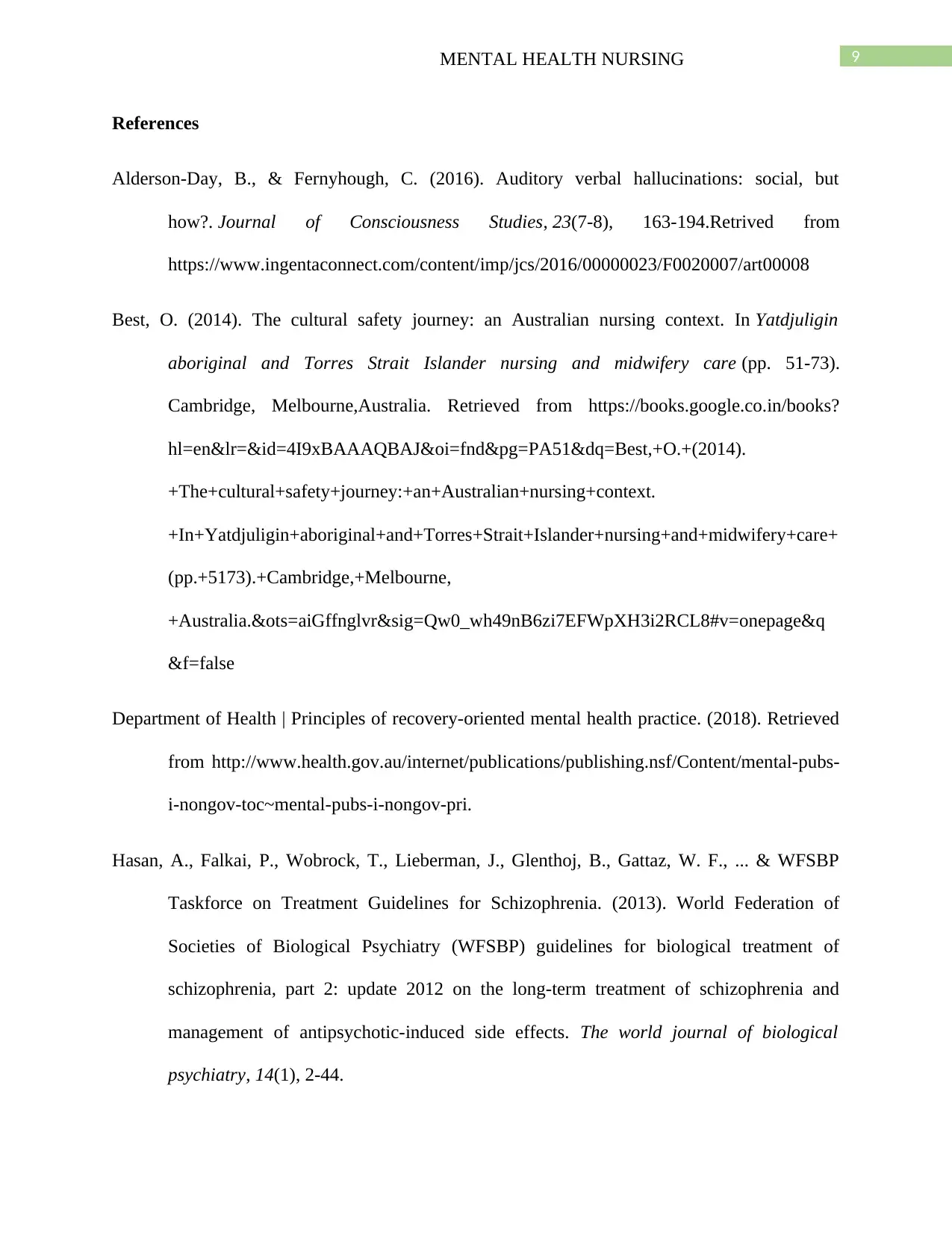
9MENTAL HEALTH NURSING
References
Alderson-Day, B., & Fernyhough, C. (2016). Auditory verbal hallucinations: social, but
how?. Journal of Consciousness Studies, 23(7-8), 163-194.Retrived from
https://www.ingentaconnect.com/content/imp/jcs/2016/00000023/F0020007/art00008
Best, O. (2014). The cultural safety journey: an Australian nursing context. In Yatdjuligin
aboriginal and Torres Strait Islander nursing and midwifery care (pp. 51-73).
Cambridge, Melbourne,Australia. Retrieved from https://books.google.co.in/books?
hl=en&lr=&id=4I9xBAAAQBAJ&oi=fnd&pg=PA51&dq=Best,+O.+(2014).
+The+cultural+safety+journey:+an+Australian+nursing+context.
+In+Yatdjuligin+aboriginal+and+Torres+Strait+Islander+nursing+and+midwifery+care+
(pp.+5173).+Cambridge,+Melbourne,
+Australia.&ots=aiGffnglvr&sig=Qw0_wh49nB6zi7EFWpXH3i2RCL8#v=onepage&q
&f=false
Department of Health | Principles of recovery-oriented mental health practice. (2018). Retrieved
from http://www.health.gov.au/internet/publications/publishing.nsf/Content/mental-pubs-
i-nongov-toc~mental-pubs-i-nongov-pri.
Hasan, A., Falkai, P., Wobrock, T., Lieberman, J., Glenthoj, B., Gattaz, W. F., ... & WFSBP
Taskforce on Treatment Guidelines for Schizophrenia. (2013). World Federation of
Societies of Biological Psychiatry (WFSBP) guidelines for biological treatment of
schizophrenia, part 2: update 2012 on the long-term treatment of schizophrenia and
management of antipsychotic-induced side effects. The world journal of biological
psychiatry, 14(1), 2-44.
References
Alderson-Day, B., & Fernyhough, C. (2016). Auditory verbal hallucinations: social, but
how?. Journal of Consciousness Studies, 23(7-8), 163-194.Retrived from
https://www.ingentaconnect.com/content/imp/jcs/2016/00000023/F0020007/art00008
Best, O. (2014). The cultural safety journey: an Australian nursing context. In Yatdjuligin
aboriginal and Torres Strait Islander nursing and midwifery care (pp. 51-73).
Cambridge, Melbourne,Australia. Retrieved from https://books.google.co.in/books?
hl=en&lr=&id=4I9xBAAAQBAJ&oi=fnd&pg=PA51&dq=Best,+O.+(2014).
+The+cultural+safety+journey:+an+Australian+nursing+context.
+In+Yatdjuligin+aboriginal+and+Torres+Strait+Islander+nursing+and+midwifery+care+
(pp.+5173).+Cambridge,+Melbourne,
+Australia.&ots=aiGffnglvr&sig=Qw0_wh49nB6zi7EFWpXH3i2RCL8#v=onepage&q
&f=false
Department of Health | Principles of recovery-oriented mental health practice. (2018). Retrieved
from http://www.health.gov.au/internet/publications/publishing.nsf/Content/mental-pubs-
i-nongov-toc~mental-pubs-i-nongov-pri.
Hasan, A., Falkai, P., Wobrock, T., Lieberman, J., Glenthoj, B., Gattaz, W. F., ... & WFSBP
Taskforce on Treatment Guidelines for Schizophrenia. (2013). World Federation of
Societies of Biological Psychiatry (WFSBP) guidelines for biological treatment of
schizophrenia, part 2: update 2012 on the long-term treatment of schizophrenia and
management of antipsychotic-induced side effects. The world journal of biological
psychiatry, 14(1), 2-44.
Secure Best Marks with AI Grader
Need help grading? Try our AI Grader for instant feedback on your assignments.
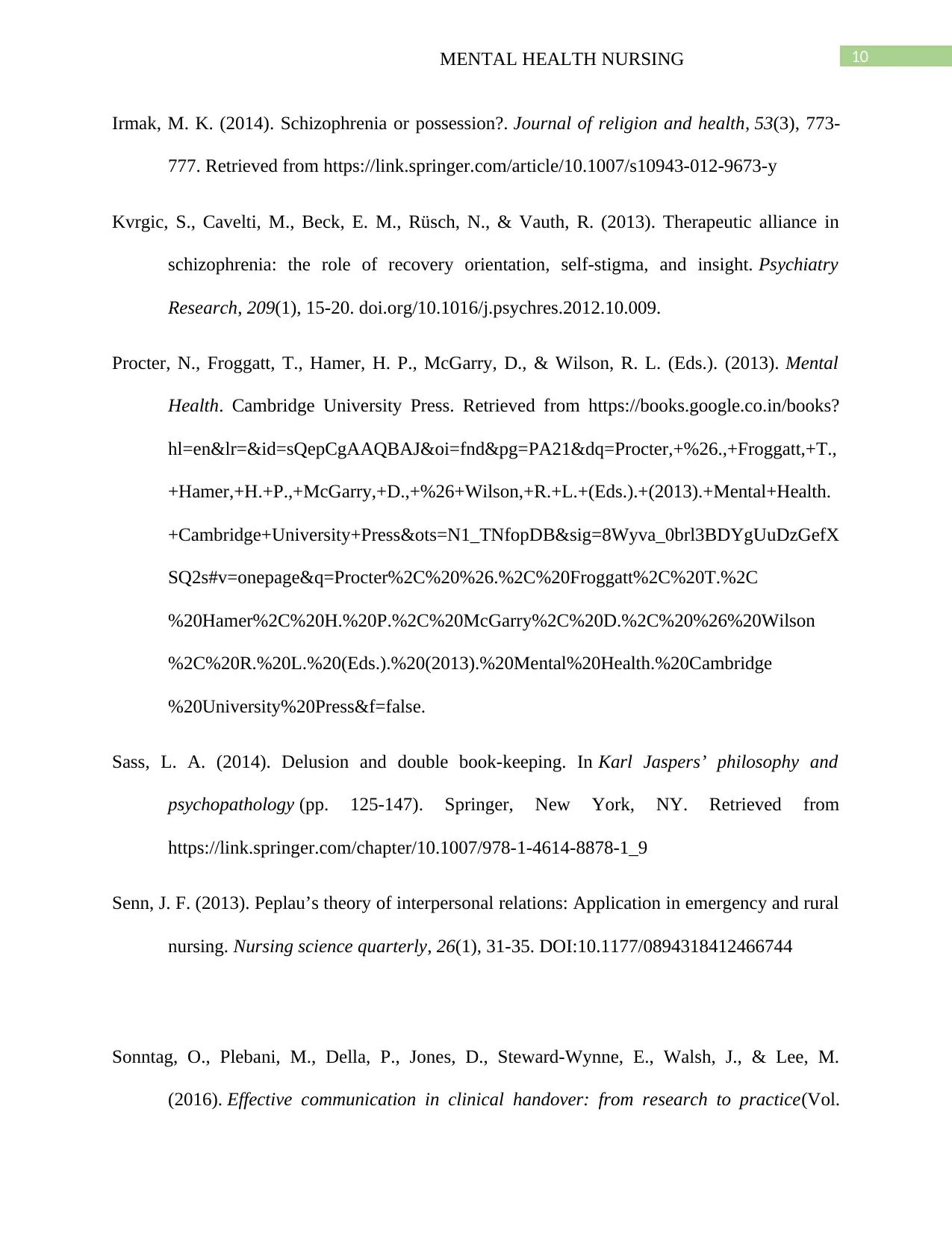
10MENTAL HEALTH NURSING
Irmak, M. K. (2014). Schizophrenia or possession?. Journal of religion and health, 53(3), 773-
777. Retrieved from https://link.springer.com/article/10.1007/s10943-012-9673-y
Kvrgic, S., Cavelti, M., Beck, E. M., Rüsch, N., & Vauth, R. (2013). Therapeutic alliance in
schizophrenia: the role of recovery orientation, self-stigma, and insight. Psychiatry
Research, 209(1), 15-20. doi.org/10.1016/j.psychres.2012.10.009.
Procter, N., Froggatt, T., Hamer, H. P., McGarry, D., & Wilson, R. L. (Eds.). (2013). Mental
Health. Cambridge University Press. Retrieved from https://books.google.co.in/books?
hl=en&lr=&id=sQepCgAAQBAJ&oi=fnd&pg=PA21&dq=Procter,+%26.,+Froggatt,+T.,
+Hamer,+H.+P.,+McGarry,+D.,+%26+Wilson,+R.+L.+(Eds.).+(2013).+Mental+Health.
+Cambridge+University+Press&ots=N1_TNfopDB&sig=8Wyva_0brl3BDYgUuDzGefX
SQ2s#v=onepage&q=Procter%2C%20%26.%2C%20Froggatt%2C%20T.%2C
%20Hamer%2C%20H.%20P.%2C%20McGarry%2C%20D.%2C%20%26%20Wilson
%2C%20R.%20L.%20(Eds.).%20(2013).%20Mental%20Health.%20Cambridge
%20University%20Press&f=false.
Sass, L. A. (2014). Delusion and double book-keeping. In Karl Jaspers’ philosophy and
psychopathology (pp. 125-147). Springer, New York, NY. Retrieved from
https://link.springer.com/chapter/10.1007/978-1-4614-8878-1_9
Senn, J. F. (2013). Peplau’s theory of interpersonal relations: Application in emergency and rural
nursing. Nursing science quarterly, 26(1), 31-35. DOI:10.1177/0894318412466744
Sonntag, O., Plebani, M., Della, P., Jones, D., Steward-Wynne, E., Walsh, J., & Lee, M.
(2016). Effective communication in clinical handover: from research to practice(Vol.
Irmak, M. K. (2014). Schizophrenia or possession?. Journal of religion and health, 53(3), 773-
777. Retrieved from https://link.springer.com/article/10.1007/s10943-012-9673-y
Kvrgic, S., Cavelti, M., Beck, E. M., Rüsch, N., & Vauth, R. (2013). Therapeutic alliance in
schizophrenia: the role of recovery orientation, self-stigma, and insight. Psychiatry
Research, 209(1), 15-20. doi.org/10.1016/j.psychres.2012.10.009.
Procter, N., Froggatt, T., Hamer, H. P., McGarry, D., & Wilson, R. L. (Eds.). (2013). Mental
Health. Cambridge University Press. Retrieved from https://books.google.co.in/books?
hl=en&lr=&id=sQepCgAAQBAJ&oi=fnd&pg=PA21&dq=Procter,+%26.,+Froggatt,+T.,
+Hamer,+H.+P.,+McGarry,+D.,+%26+Wilson,+R.+L.+(Eds.).+(2013).+Mental+Health.
+Cambridge+University+Press&ots=N1_TNfopDB&sig=8Wyva_0brl3BDYgUuDzGefX
SQ2s#v=onepage&q=Procter%2C%20%26.%2C%20Froggatt%2C%20T.%2C
%20Hamer%2C%20H.%20P.%2C%20McGarry%2C%20D.%2C%20%26%20Wilson
%2C%20R.%20L.%20(Eds.).%20(2013).%20Mental%20Health.%20Cambridge
%20University%20Press&f=false.
Sass, L. A. (2014). Delusion and double book-keeping. In Karl Jaspers’ philosophy and
psychopathology (pp. 125-147). Springer, New York, NY. Retrieved from
https://link.springer.com/chapter/10.1007/978-1-4614-8878-1_9
Senn, J. F. (2013). Peplau’s theory of interpersonal relations: Application in emergency and rural
nursing. Nursing science quarterly, 26(1), 31-35. DOI:10.1177/0894318412466744
Sonntag, O., Plebani, M., Della, P., Jones, D., Steward-Wynne, E., Walsh, J., & Lee, M.
(2016). Effective communication in clinical handover: from research to practice(Vol.
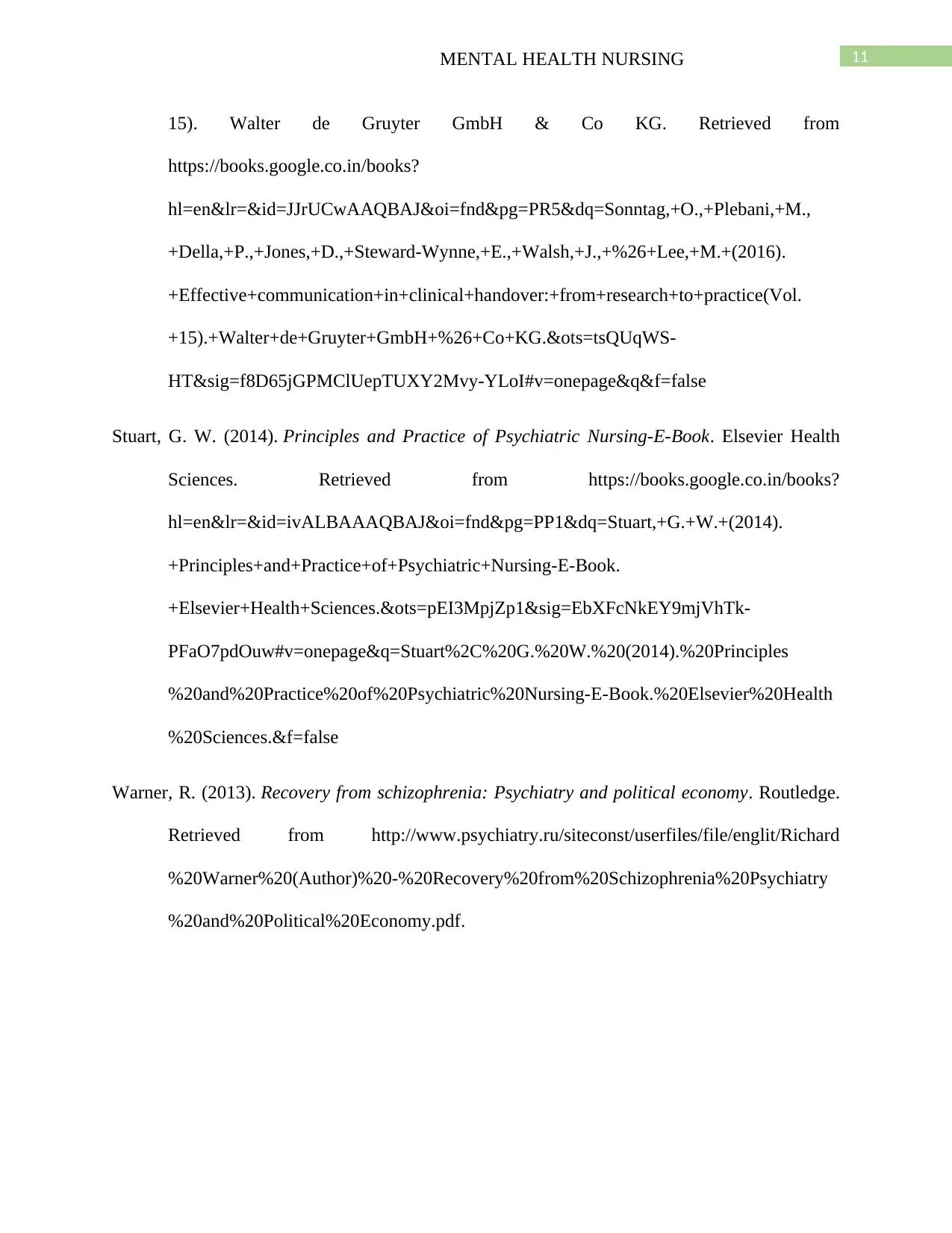
11MENTAL HEALTH NURSING
15). Walter de Gruyter GmbH & Co KG. Retrieved from
https://books.google.co.in/books?
hl=en&lr=&id=JJrUCwAAQBAJ&oi=fnd&pg=PR5&dq=Sonntag,+O.,+Plebani,+M.,
+Della,+P.,+Jones,+D.,+Steward-Wynne,+E.,+Walsh,+J.,+%26+Lee,+M.+(2016).
+Effective+communication+in+clinical+handover:+from+research+to+practice(Vol.
+15).+Walter+de+Gruyter+GmbH+%26+Co+KG.&ots=tsQUqWS-
HT&sig=f8D65jGPMClUepTUXY2Mvy-YLoI#v=onepage&q&f=false
Stuart, G. W. (2014). Principles and Practice of Psychiatric Nursing-E-Book. Elsevier Health
Sciences. Retrieved from https://books.google.co.in/books?
hl=en&lr=&id=ivALBAAAQBAJ&oi=fnd&pg=PP1&dq=Stuart,+G.+W.+(2014).
+Principles+and+Practice+of+Psychiatric+Nursing-E-Book.
+Elsevier+Health+Sciences.&ots=pEI3MpjZp1&sig=EbXFcNkEY9mjVhTk-
PFaO7pdOuw#v=onepage&q=Stuart%2C%20G.%20W.%20(2014).%20Principles
%20and%20Practice%20of%20Psychiatric%20Nursing-E-Book.%20Elsevier%20Health
%20Sciences.&f=false
Warner, R. (2013). Recovery from schizophrenia: Psychiatry and political economy. Routledge.
Retrieved from http://www.psychiatry.ru/siteconst/userfiles/file/englit/Richard
%20Warner%20(Author)%20-%20Recovery%20from%20Schizophrenia%20Psychiatry
%20and%20Political%20Economy.pdf.
15). Walter de Gruyter GmbH & Co KG. Retrieved from
https://books.google.co.in/books?
hl=en&lr=&id=JJrUCwAAQBAJ&oi=fnd&pg=PR5&dq=Sonntag,+O.,+Plebani,+M.,
+Della,+P.,+Jones,+D.,+Steward-Wynne,+E.,+Walsh,+J.,+%26+Lee,+M.+(2016).
+Effective+communication+in+clinical+handover:+from+research+to+practice(Vol.
+15).+Walter+de+Gruyter+GmbH+%26+Co+KG.&ots=tsQUqWS-
HT&sig=f8D65jGPMClUepTUXY2Mvy-YLoI#v=onepage&q&f=false
Stuart, G. W. (2014). Principles and Practice of Psychiatric Nursing-E-Book. Elsevier Health
Sciences. Retrieved from https://books.google.co.in/books?
hl=en&lr=&id=ivALBAAAQBAJ&oi=fnd&pg=PP1&dq=Stuart,+G.+W.+(2014).
+Principles+and+Practice+of+Psychiatric+Nursing-E-Book.
+Elsevier+Health+Sciences.&ots=pEI3MpjZp1&sig=EbXFcNkEY9mjVhTk-
PFaO7pdOuw#v=onepage&q=Stuart%2C%20G.%20W.%20(2014).%20Principles
%20and%20Practice%20of%20Psychiatric%20Nursing-E-Book.%20Elsevier%20Health
%20Sciences.&f=false
Warner, R. (2013). Recovery from schizophrenia: Psychiatry and political economy. Routledge.
Retrieved from http://www.psychiatry.ru/siteconst/userfiles/file/englit/Richard
%20Warner%20(Author)%20-%20Recovery%20from%20Schizophrenia%20Psychiatry
%20and%20Political%20Economy.pdf.
1 out of 12
Related Documents
Your All-in-One AI-Powered Toolkit for Academic Success.
+13062052269
info@desklib.com
Available 24*7 on WhatsApp / Email
![[object Object]](/_next/static/media/star-bottom.7253800d.svg)
Unlock your academic potential
© 2024 | Zucol Services PVT LTD | All rights reserved.





